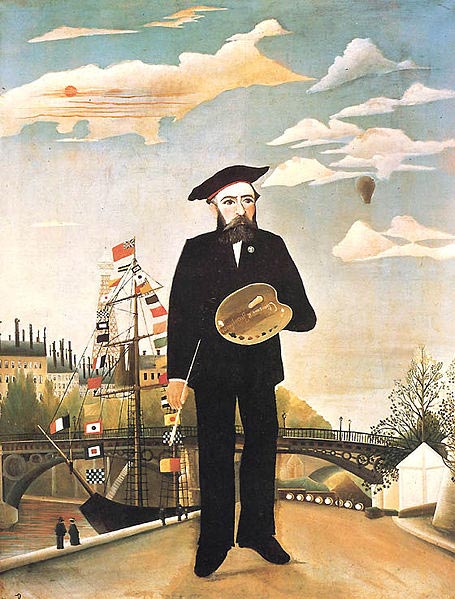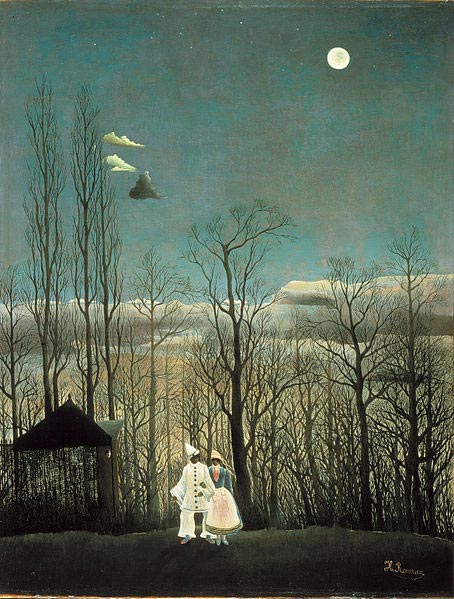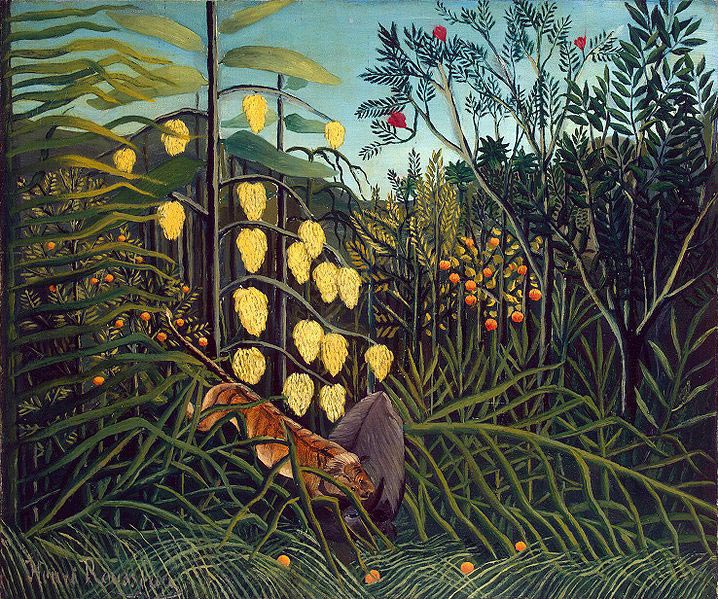| Henri Rousseau | |
|---|---|
 |
|
| Born | May 21, 1844 Laval, Mayenne |
| Died | Sep. 2, 1910 (at age 66) Paris, France |
| Nationality | French |
| Education | Self-taught |
| Movement | Post-Impressionism, Naïve art, Primitivism |
| Field | Painting |
Art comes in many forms, and each form of art comes in different styles. Paintings are some of the most popular forms of art. People know of formal looking paintings such as works from Da Vinci or Van Gogh. Another style is seen in works with childlike simplicity. This is known as Naïve art. One artist who became known for Naïve art was Henri Rousseau.
Henri Julien Félix Rousseau was known as a French Post-Impressionist artist utilizing Naïve or Primitive style. In the course of his life, he also acquired a nickname of “Le Douanier” which means “the customs officer.” This was a humorous take on his job as a tax collector. Scorned at during his life, he came out as a self-educated genius; his works acclaimed to have a prominent artistic quality.
He was born on May 21, 1844 in the town of Laval, France in Loire Valley. The young Henri became a boarding student at the Lycee of Laval because of their frequent movements due to his tinsmith father’s penchant for acquiring debts. At school, his grades in some subjects were not remarkable. Drawing and Music are another case. He gets high grades and awards in them.
When he was 19, he worked for a lawyer. Then, he was arrested because of perjury at his employer’s office. To evade a severe jail sentence, he served the army, starting in 1863, for four years.
When his father died, he moved in 1868 to Paris to help his mother by working as a government employee. In the same year, he married the then 15-year-old Clémence Boitard, the daughter of his landlord. They had six children but only one survived. When 1871 came, he became a collector of octroi tax on products entering Paris, thus, his nickname Le Douanier. He remarried in 1898, this time to Josephine Noury, a year after his first wife died. He delved into serious painting when he was in his early forties. At age 49, he retired from his job to paint full-time.
 Although he admitted receiving advice from two reputable academic painters, namely, Félix Auguste-Clément and Jean-Léon Gérôme, Henri Rosseau claimed that his only teacher was nature. He was self-taught and worked on Naïve art.
Although he admitted receiving advice from two reputable academic painters, namely, Félix Auguste-Clément and Jean-Léon Gérôme, Henri Rosseau claimed that his only teacher was nature. He was self-taught and worked on Naïve art.
Rosseau was well recognized for his artistic depictions of jungles. This is considering that he had never left France or seen a jungle. There were rumors that he had an expedition to Mexico when he was in the army, and this was where he experienced jungles. These were not necessarily true. In reality, he was inspired by illustrations in books and botanical gardens in Paris. Also, he looked at assortments of taxidermies of wild animals. He had also listened to stories brought home by soldiers who actually went with the French Expedition to Mexico.
Aside from exotic scenes, he also painted some small topographical images of suburbs and his city. According to him, he had invented a new style of portrait landscape. He did this by painting a beautiful view, then adding the portrait in the foreground.
 With the Naïve art Henri Rosseau did, the first flow of criticism was not very favorable. At first, viewers either made fun of or were shocked by his works. He worked hard to gain conventional appreciation. Many said that his paintings were like drawings done by a child but his works show sophistication with his chosen technique.
With the Naïve art Henri Rosseau did, the first flow of criticism was not very favorable. At first, viewers either made fun of or were shocked by his works. He worked hard to gain conventional appreciation. Many said that his paintings were like drawings done by a child but his works show sophistication with his chosen technique.
Starting 1886, he regularly conducted exhibits at the Salon des Indépendants. His works were not featured prominently but attracted followers over the years.
In 1891, Tiger in a Tropical Storm (Surprised!) went into exhibition. It is an oil-on-canvas painting depicting a tiger illuminated by lightning flash, ready to pounce on his prey. This was when he first got a serious review. Félix Vallotton, a Swiss painter who later became a prominent figure in modern woodcut, gave a positive take on his work, mentioning that it was a ‘must-see’ and ‘alpha and omega of painting.’ This work was the first of Rousseau’s jungle depictions.
 In spite of Vallotto’s good review, most of the other comments were negative. Because of this, it took ten years before Henri Rousseau followed up on more jungle depictions. His work entitled The Hungry Lion Throws Itself on the Antelope was exhibited at the Salon des Indépendants where it was placed side by side with works by Derain and Matisse.
In spite of Vallotto’s good review, most of the other comments were negative. Because of this, it took ten years before Henri Rousseau followed up on more jungle depictions. His work entitled The Hungry Lion Throws Itself on the Antelope was exhibited at the Salon des Indépendants where it was placed side by side with works by Derain and Matisse.
Another notable work of Rousseau was an oil painting of a lion musing over a woman who was asleep on a night illuminated by the moon. This was entitled The Sleeping Gypsy. He tried to have it sold to the mayor of Laval, but it ended up in a private collection of a Parisian charcoal merchant. It stayed there until 1924.
Rousseau’s final painting was The Dream. It was exhibited first in 1910, a few months before he died. In the painting was a nude woman on a plush divan resting in the midst of a jungle’s thick foliage and different creatures.
Rousseau’s art, although previously ridiculed, had an extensive influence on artists such as Picasso, Jean Hugo, Beckman, and Surrealists. In the 1998 animated film, Kirikou and the Sorceress by Michel Ocelot, the visual style was partially inspired by Rousseau – evident in the jungle vegetation. Joni Mitchell’s song, The Jungle Line is based on a painting by Rousseau. Another animated film, entitled Madagascar, used one of Henri Rousseau’s works as an inspiration.